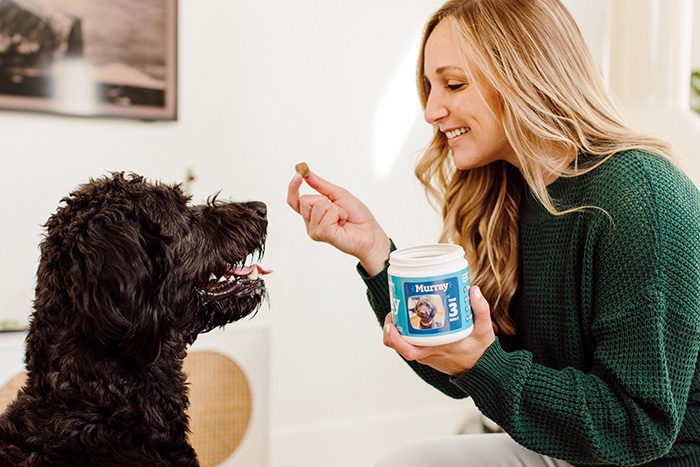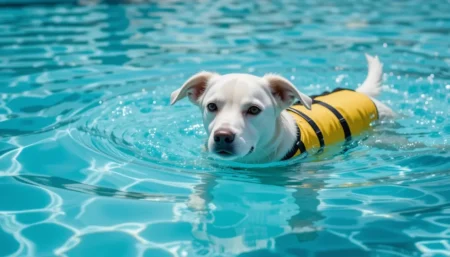English Labradors are a distinct type of Labrador Retriever bred primarily for conformation shows rather than field work. They feature a stockier build, broader chest, and blockier head compared to their American counterparts.
Known for their calm, friendly temperament and affectionate nature, these dogs make excellent family companions when properly socialized. English Labradors typically display a more relaxed energy level while maintaining the breed’s signature intelligence and trainability.
Developed in the UK as show dogs, English Labradors have become increasingly popular as family pets worldwide.
Their distinctive appearance and gentle personality set them apart from working-line American Labradors.
This comprehensive guide covers everything you need to know about English Labrador characteristics, care requirements, health considerations, and how to provide the best life for your four-legged friend.
History and Development
The English Labrador represents a specific breeding line within the broader Labrador Retriever breed.
While all Labradors share common ancestry, selective breeding practices created distinct differences between English and American varieties.
Understanding this historical context helps explain the physical and behavioral traits that define modern English Labradors.
The breed’s evolution reflects changing human needs and preferences over nearly two centuries.
Origins in Newfoundland and England
The Labrador breed traces its roots to the 1830s when St. John’s water dogs, bred by European settlers in Newfoundland, were first introduced to England.
These versatile water dogs caught the attention of British sportsmen who recognized their exceptional retrieving abilities.
English nobility began selectively breeding these dogs for specific traits that would eventually define the Labrador Retriever as we know it today.
Early English breeders focused on creating dogs with:
- Calmer temperaments are suitable for hunting companionship
- Distinctive block-shaped heads and muscular construction
- Thicker coats for protection against the cold English weather
- Shorter, stockier builds that provided stability in water
The Kennel Club officially recognized Labrador Retrievers in England in 1903, establishing formal breed standards that guided English Labrador development.
This formal recognition helped preserve the distinctive characteristics that differentiate English Labradors from their American cousins.
Divergence from American Labrador Lines
As Labradors gained popularity in North America, breeding priorities shifted toward performance in field trials and hunting. This divergence created two distinct types:
| Characteristic | English Labrador | American Labrador |
|---|---|---|
| Build | Stockier, heavier frame | Leaner, more athletic |
| Head Shape | Blockier, broader skull | Narrower, more streamlined |
| Temperament | Calmer, more relaxed | Higher energy, more intense |
| Purpose | Primarily show/conformation | Field/work performance |
English Labradors maintained their show-dog focus with breeders emphasizing physical conformation and gentle temperament.
American breeders, however, prioritized speed, stamina, and intense drive for hunting competitions.
This fundamental difference in breeding goals created the distinct varieties we recognize today, despite both being the same breed according to major kennel clubs.
Modern Recognition and Popularity
Today, English Labradors enjoy widespread popularity as family companions and show dogs.
While the American Kennel Club doesn’t formally distinguish between English and American types, the differences remain significant in breeding circles.
English Labradors consistently rank among the top 10 most popular dog breeds worldwide, with their gentle nature making them particularly suitable for families.
The growing demand for English Labradors has led to:
- Increased availability from specialized breeders
- Higher prices for show-quality puppies
- Greater awareness of proper care requirements
- More resources for English Labrador-specific health issues
Despite their show-dog heritage, modern English Labradors have adapted well to family life.
Their peaceful behavior and social nature make them stand apart from more energetic working-line Labradors.
This versatility explains their enduring appeal across diverse households and living situations.

Distinctive Physical Characteristics of English Labradors
English Labradors possess several physical traits that distinguish them from American Labradors and other breeds.
These characteristics result from generations of selective breeding focused on conformation show standards.
Understanding these features helps identify a true English Labrador and appreciate their unique beauty.
Proper recognition of these traits also ensures you’re getting an authentic English Labrador when selecting a breeder.
Build and Structure
The most noticeable difference in English Labradors is their distinctive body structure:
- Stockier frame: English Labradors have a heavier, more compact build compared to the leaner American variety
- Shorter legs: Proportionally shorter limbs create a lower center of gravity
- Broader chest: Wider ribcage provides greater lung capacity while maintaining a barrel-shaped appearance
- Thicker bone structure: More substantial bone density contributes to their sturdy appearance
This muscular construction makes English Labradors appear more “cobby” or compact than their American counterparts.
The average English Labrador stands 21.5-24.5 inches tall at the shoulder and weighs 55-80 pounds, with males typically larger than females.
Their substantial build gives them a powerful yet balanced appearance that judges favor in conformation shows.
Head and Facial Features
The head structure provides the clearest visual distinction between English and American Labradors:
- Blocky head shape: Pronounced stop and broader skull create a distinctive square appearance
- Rounder eyes: Large, expressive eyes give a softer, kinder expression
- Pudgy facial structure: Fuller cheeks and muzzle contribute to their characteristic “teddy bear” look
- Thicker neck: Muscular neck blends smoothly into the shoulders
English Labrador puppies typically display these features from a young age, with their round face and big, expressive eyes making them particularly appealing.
The block-shaped head isn’t just for show—this structure supports their powerful bite and retrieving ability while maintaining the gentle expression breeders prize.
Coat and Color Variations
English Labradors showcase the breed’s signature double coat with some distinctive qualities:
- Thicker undercoat: Provides superior insulation against cold weather
- Softer outer coat: Less coarse than working-line Labradors
- Fuller feathering: Particularly noticeable on legs, chest, and tail
- Standard colors: Black, yellow, and chocolate in various shades
The English Labrador’s coat requires regular grooming to maintain its characteristic soft, fluffy appearance.
Unlike some working lines that have been bred for a sleeker coat, English Labradors maintain the traditional dense double coat that protects them in various weather conditions.
Their coat texture feels distinctly plush to the touch, contributing to their overall luxurious appearance.
Temperament and Personality: What Makes English Labradors Special
English Labradors possess a temperament that perfectly balances their physical beauty with genuine companionship qualities.
Their personality traits make them exceptional family dogs while maintaining the working heritage of the Labrador breed.
Understanding these characteristics helps owners provide appropriate training and enrichment that matches their natural inclinations.
This section explores the defining personality traits that make English Labradors so beloved.
Calm and Gentle Disposition
The most celebrated trait of English Labradors is their remarkably calm temperament:
- Lower energy levels: Compared to American Labradors, they display more moderate energy
- Patient nature: Tolerant of children’s antics and household activity
- Quiet demeanor: Less prone to excessive barking or demanding attention
- Relaxed outlook: Content to lounge near family members without constant stimulation
This peaceful behavior makes English Labradors stand apart from more energetic Labrador varieties.
While still requiring regular exercise, they’re less likely to exhibit the hyperactive tendencies sometimes seen in working-line Labradors.
This balanced energy level makes them particularly suitable for first-time dog owners and families with young children.
Social and Affectionate Nature
English Labradors excel as companion animals due to their exceptional social skills:
- People-oriented: They thrive on human interaction and form strong family bonds
- Friendly with strangers: Properly socialized English Labradors typically welcome visitors
- Good with other pets: Generally get along well with other dogs and household animals
- Affectionate without being clingy: Enjoy cuddling but respect personal space
English Labradors are known for being affectionate, loving, and friendly companions who will readily warm up to strangers when properly introduced.
Their social and outgoing nature makes them excellent therapy dogs and ideal for multi-pet households.
Unlike some breeds that bond with a single person, English Labradors typically form strong attachments to all family members.
Intelligence and Trainability
Despite their calmer energy, English Labradors maintain the breed’s renowned intelligence:
- Eagerness to please: High motivation for positive reinforcement training
- Quick learners: Master commands with consistent, reward-based methods
- Problem-solving skills: Capable of complex tasks when properly motivated
- Adaptable personalities: Adjust well to various living situations and routines
This combination of intelligence and willingness to work makes English Labradors highly trainable.
Their high energy and eagerness to please also help shape their responsive personality.
While they may not have the intense drive of field-bred Labradors, they excel in obedience, therapy work, and family companionship roles.
Proper socialization from puppyhood ensures they develop into well-rounded adult dogs.
Health Considerations for English Labradors
Like all purebred dogs, English Labradors face certain health challenges that responsible owners should understand.
Awareness of these potential issues enables proactive care and early intervention when problems arise.
While generally healthy, English Labradors inherit some breed-specific vulnerabilities that require monitoring throughout their lives.
This section outlines the most common health concerns and how to maintain optimal well-being.
Common Genetic Health Issues
English Labradors share several health concerns with the broader Labrador breed:
- Hip and elbow dysplasia: Abnormal joint development affecting mobility
- Progressive retinal atrophy (PRA): Gradual vision loss leading to blindness
- Exercise-induced collapse (EIC): Sudden weakness after intense activity
- Hereditary myopathy: A Muscle weakness condition affecting some lines
Responsible breeders conduct health screenings to minimize these risks. The Orthopedic Foundation for Animals recommends hip and elbow evaluations, eye examinations, and EIC genetic testing for breeding stock.
When selecting an English Labrador puppy, always request documentation of these health clearances from the breeder.
Obesity Prevention Strategies
English Labradors face a particularly high risk of obesity due to their food-motivated nature:
- Calorie monitoring: Measure all food portions rather than free-feeding
- Regular weigh-ins: Track weight monthly to catch gains early
- Appropriate exercise: Minimum 60 minutes of daily activity adjusted for age
- Treat management: Limit treats to 10% of daily calories
A study by the Royal Veterinary College found Labradors are 1.6 times more likely to become obese than other breeds.
Their stockier build makes excess weight particularly problematic for joint health.
English Labradors’ heavier build requires careful attention to prevent obesity-related complications that could shorten their lifespan.
Lifespan and Senior Care
English Labradors typically live 10-12 years with proper care, though many reach 13-14 years:
- Senior transition: Considered seniors at 8-9 years due to their size
- Joint support: Glucosamine supplements and orthopedic beds become essential
- Diet adjustments: Lower-calorie, higher-fiber formulas for aging metabolism
- Regular veterinary checks: Bi-annual exams to catch age-related issues early
As English Labradors age, their stockier build may lead to an earlier onset of arthritis compared to leaner dogs.
Maintaining a healthy weight throughout life significantly extends their mobility in senior years.
Many owners report their English Labradors remain active well into their teens with proper care and management of age-related conditions.

Daily Care Requirements for English Labradors
Providing proper daily care ensures your English Labrador remains healthy and happy throughout their life.
Their specific needs differ somewhat from American Labradors due to their physical structure and temperament.
Understanding these requirements helps create a comfortable environment that supports their well-being.
This section details the essential care routines every English Labrador owner should implement.
Exercise Needs and Mental Stimulation
Despite their calmer nature, English Labradors still require regular physical and mental activity:
- Daily exercise: 45-60 minutes of moderate activity (walks, playtime, swimming)
- Mental challenges: Puzzle toys, scent games, and obedience practice
- Swimming opportunities: Natural ability makes water exercise ideal
- Social interaction: Regular playdates with other friendly dogs
While English Labradors generally have a more relaxed energy level than working lines, they still need consistent exercise to prevent boredom-related behaviors.
Their muscular construction benefits from low-impact activities like swimming that reduce joint strain.
Incorporating training into exercise sessions satisfies both physical and mental needs while strengthening your bond.
Grooming and Coat Maintenance
The English Labrador’s thicker double coat requires regular attention:
- Brushing routine:
- 2-3 times weekly with a slicker brush and undercoat rake
- Daily during seasonal shedding periods (spring and fall)
- Focus on mat-prone areas: behind ears, under legs, tail base
- Bathing protocol:
- Every 4-6 weeks with dog-specific shampoo
- Thorough drying to prevent skin issues
- Check ears for moisture after swimming
- Nail and dental care:
- Trim nails monthly to prevent overgrowth
- Brush teeth 2-3 times weekly for oral health
- Provide dental chews as supplements
English Labradors shed year-round with heavier “blowouts” twice annually. Their softer, fluffy coat requires more frequent brushing than working-line varieties to prevent matting.
Professional grooming every 3-4 months can help maintain their coat, especially during peak shedding seasons.
Nutritional Requirements
Proper nutrition supports the English Labrador’s distinctive build and energy needs:
- High-quality protein: 18-25% protein content appropriate for moderate activity
- Joint support: Glucosamine and chondroitin for a stockier frame
- Controlled calories: Prevent obesity while maintaining muscle mass
- Omega-3 fatty acids: Support skin and coat health
Feeding guidelines by weight:
| Weight Range | Daily Calories | Meals Per Day |
|---|---|---|
| 55-65 lbs | 1,200-1,400 | 2 |
| 66-75 lbs | 1,400-1,600 | 2 |
| 76-85 lbs | 1,600-1,800 | 2 |
Always consult your veterinarian about specific dietary needs based on your English Labrador’s age, activity level, and health status.
Their heavier build requires careful attention to prevent weight gain that could strain joints.
Many owners find measured meals with scheduled feeding times work better than free-feeding for maintaining ideal weight.
English Labrador vs. American Labrador: Key Differences
Understanding the distinction between English and American Labradors helps prospective owners choose the right fit for their lifestyle.
While both are Labrador Retrievers, generations of selective breeding have created notable differences.
This comparison clarifies the physical and behavioral variations that define each type.
Recognizing these differences prevents disappointment when a dog’s characteristics don’t match expectations.
Physical Differences at a Glance
The most apparent distinctions appear in their physical structure:
| Feature | English Labrador | American Labrador |
|---|---|---|
| Build | Stockier, heavier frame | Leaner, more athletic |
| Height | Slightly shorter (21.5-24.5″) | Slightly taller (22.5-24.5″) |
| Weight | Heavier for height | Lighter for height |
| Head Shape | Blockier, broader skull | Narrower, more streamlined |
| Eyes | Rounder, softer expression | Almond-shaped, more alert |
| Coat | Thicker, softer texture | Slightly coarser, sleeker |
English Labradors generally have a broader chest and heavier build that gives them a more substantial appearance.
Their block-shaped heads and muscular construction create a distinctive look that conformation shows judges favor.
American Labradors, bred for field work, display a more streamlined physique optimized for speed and endurance.
Temperament and Energy Level Comparison
Behavioral differences significantly impact suitability for various households:
- English Labrador: Calmer, more laid-back personality with moderate energy levels
- American Labrador: Higher drive, more intense focus, and greater energy reserves
English Labradors tend to have calm, laid-back personalities that make them excellent show dogs and family companions.
They’re generally more relaxed in the home environment while still enjoying outdoor activities.
American Labradors often display the intense “hunt drive” that makes them excel in field trials, but can be challenging for first-time owners.
Choosing the Right Type for Your Lifestyle
Consider these factors when deciding between English and American Labradors:
- English Labrador best suits:
- First-time dog owners
- Families with young children
- Those wanting a more relaxed companion
- Show dog enthusiasts
- Apartment or smaller home dwellers (with adequate exercise)
- American Labrador best suits:
- Active owners who hike/run regularly
- Those interested in dog sports
- Hunting or field activity participants
- Experienced dog owners
- Larger properties with space to run
English Labradors possess the peaceful behavior that makes them ideal for households seeking a gentle, affectionate companion.
Their social and outgoing nature, combined with moderate energy, creates a balanced pet for most family situations.
American Labradors thrive with owners who can provide intense physical and mental challenges matching their working heritage.
Training Tips for English Labrador Puppies
Early training establishes the foundation for a well-behaved adult English Labrador.
Their intelligence and eagerness to please make them highly trainable, but their gentle nature requires appropriate methods.
Understanding their specific learning style ensures effective communication and strengthens your bond.
This section provides practical training strategies tailored to English Labrador puppies’ unique characteristics.
Socialization Essentials
Proper socialization prevents fear-based behaviors in adult English Labradors:
- Early exposure: Introduce to various people, animals, and environments between 3-14 weeks
- Positive associations: Pair new experiences with treats and praise
- Controlled interactions: Avoid overwhelming situations that create negative associations
- Continued exposure: Maintain socialization throughout the first year
English Labradors generally get along well with everyone, including other dogs and strangers, when they’ve had proper training and socialization.
Their friendly and upbeat temperament makes them receptive to socialization, but their calmer nature means they may need more time to adjust to new situations than high-energy puppies.
Always monitor body language for signs of stress during socialization sessions.
Basic Obedience Training Approach
English Labradors respond best to positive reinforcement methods:
- Start with fundamentals:
- Short sessions (5-10 minutes) multiple times daily
- High-value rewards for immediate reinforcement
- Clear, consistent commands with hand signals
- Key commands to prioritize:
- Sit (foundation for many behaviors)
- Stay (builds impulse control)
- Come (critical for safety)
- Leave it (prevents dangerous item ingestion)
- Troubleshooting common issues:
- For distraction: Increase distance from distractions
- For lack of interest: Use higher-value rewards
- For inconsistent response: Check for unclear cues
Their eagerness to please makes English Labradors highly responsive to reward-based training.
Their calmer temperament means they may not respond as quickly to high-energy training methods that work for American Labradors.
Patience and consistency yield the best results with these intelligent but sometimes methodical learners.
Crate Training Success Strategies
Crate training provides security and aids in housebreaking:
- Positive introduction: Feed meals and give treats inside the crate
- Gradual acclimation: Start with short periods while you’re present
- Comfortable setup: Include soft bedding and safe chew toys
- Appropriate timing: Never exceed age-appropriate duration (hours = age in months + 1)
English Labradors’ affectionate nature makes them particularly receptive to crate training when done properly.
Their social tendencies mean they may initially resist separation, so gradual introduction is essential.
A properly crate-trained English Labrador views their crate as a safe den rather than punishment, providing security during travel and reducing separation anxiety.
FAQs
How much exercise does an English Labrador need?
English Labradors need 45-60 minutes of moderate daily exercise despite their calmer nature. Their stockier build benefits from low-impact activities like swimming and walking rather than high-intensity running. Adjust exercise based on age and health—puppies need shorter sessions, while seniors may prefer gentle walks. Consistent exercise prevents boredom and maintains their muscular frame without straining joints.
Are English Labradors good with children?
Yes, English Labradors excel with children due to their patient, gentle temperament. Their peaceful behavior makes them stand apart from more energetic breeds that might accidentally knock over small children. Always supervise interactions, teach children respectful handling, and provide your dog with quiet spaces to retreat. Early socialization with children ensures positive associations that last throughout their lives.
What’s the difference between English and British Labradors?
There is no difference—English Labradors are British Labradors. The terms are used interchangeably to describe Labradors bred to the UK conformation standard. Some American breeders use “English” to distinguish show-line dogs from “American” field-line dogs. True English Labradors originate from British bloodlines with the characteristic blocky head and stockier build, regardless of where they’re bred today.
Do English Labradors shed less than other Labradors?
No, English Labradors shed just as much as other Labradors due to their double coat. Their softer, fluffier coat may appear to shed differently, but it requires similar grooming. They experience seasonal “blowouts” where they lose large amounts of undercoat, typically in spring and fall. Regular brushing controls shedding better than any breed variation—frequency matters more than type.
How do I find a reputable English Labrador breeder?
Look for breeders who health-test parents for hips, elbows, eyes, and EIC. Visit their facility to see living conditions and meet the puppy’s parents. Reputable breeders ask you questions to ensure a good match and provide documentation of health clearances. Avoid breeders with multiple litters available year-round or those who won’t let you see where puppies are raised. The English Labrador Retriever Club can provide breeder referrals with strict ethical standards.
Conclusion
English Labradors offer the perfect blend of gentle temperament and loyal companionship that makes them exceptional family dogs.
Their distinctive stockier build, blocky head, and calm personality set them apart while maintaining the beloved Labrador traits of friendliness and intelligence.
Proper care—including regular grooming, measured exercise, and consistent training—ensures your English Labrador thrives as a cherished family member.
For immediate improvement in your dog’s well-being, implement a structured daily routine with set times for meals, exercise, and rest; this predictability reduces anxiety and reinforces good behavior in these social, outgoing dogs.
Remember that the most successful English Labrador relationships develop through understanding their unique needs and celebrating their special qualities as both show dogs and devoted companions.
With proper care and attention, your English Labrador will provide years of joyful companionship that perfectly balances regal appearance with genuine affection.






